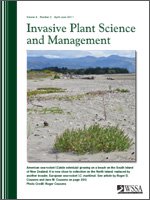Smooth brome and Kentucky bluegrass are introduced cool-season perennial grasses known to invade grasslands throughout North America. During the fall of 2005 and spring of 2006, we implemented a restoration study at six native prairie sites in eastern South Dakota that have been invaded by smooth brome and Kentucky bluegrass. Treatments included five herbicide combinations, a fall prescribed burn, and an untreated control to determine the potential of each for renovation of invaded native grasslands. Herbicide treatments tested were sulfosulfuron, imazapyr, imazapic sulfosulfuron, and imazapyr imazapic, and were applied in late September 2005 and mid-May 2006. Untreated control plots averaged 64% (± 3.1) smooth brome cover and 38% (± 5.5) Kentucky bluegrass cover after the third growing season. Smooth brome cover in herbicide treated plots ranged from 6 to 23% and Kentucky bluegrass cover ranged from 15 to 35% after the third growing season. Smooth brome cover was 20% (± 2.9) and Kentucky bluegrass cover was 19% (± 4.0) in burned plots after the third growing season. Spring and fall treatments had similar native plant cover after three growing seasons. Spring and fall application of 0.33 kg ai ha−1 imazapyr and 0.10 kg ai ha−1 imazapic 0.16 kg ai ha−1 imazapyr had ≤ 10% smooth brome cover and increased native species cover after three growing seasons. Herbicides were effective at reducing cover of smooth brome and Kentucky bluegrass, and can be incorporated with other management strategies to restore prairie remnants.
Nomenclature: imazapic, (±)-2-[4,5-dihydro-4-methyl-4-(1-methylethyl)-5-oxo-1H-imidazol-2-yl]-5-methyl-3-pyridinecarboxylic acid; imazapyr, (±)-2-[4,5-dihydro-4-methyl-4-(1-methylethyl)-5-oxo-1H-imidazol-2-yl]-3-pyridinecarboxylic acid; sulfosulfuron, (±)-1-(4,6-dimethoxypyrimidin-2-yl)-3-[(2-ethanesulfonyl-imidazo[1,2-a]pyridine-3-yl)sulfonylurea; Kentucky bluegrass, Poa pratensis L. POAPR. smooth brome, Bromus inermis Leyss. BROIN
Interpretive Summary: Smooth brome and Kentucky bluegrass are introduced forage grasses that are known to invade native grasslands throughout North America. Effective management strategies for controlling these species in native grasslands have not been developed. In this study we compared the efficacy of prescribed fire and multiple herbicide combinations to control smooth brome and Kentucky bluegrass while minimizing harm to native species. We evaluated spring and fall application of herbicides to determine if they have any significant effect (positive or negative) on these species, as well as native species. Our results indicate that several herbicide combinations show potential for restoring native prairie fragments, but prescribed fire did not provide adequate long-term control. Applications of imazapyr herbicide resulted in the most consistent control of smooth brome. Initial reductions in Kentucky bluegrass cover were observed during the study, but cover increased throughout the study and likely will require further management to achieve desired control. Spring-treated plots had much more bare ground and visible injury to surviving plants than did the fall treatments after the first growing season. These herbicide treatments reduced cover of smooth brome and Kentucky bluegrass and can be integrated with other strategies to restore native prairie remnants.





